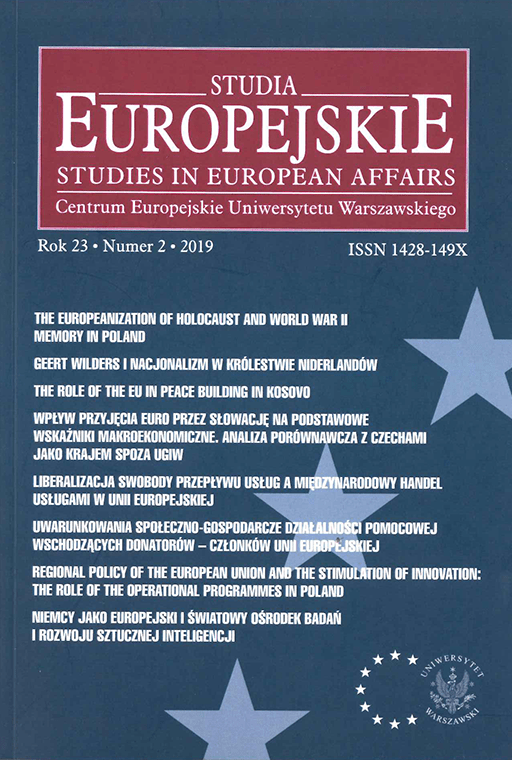
ISSUE: 2/2019
- Volume 23
- Number 2
- 2019
Subscribe NEWSLETTER
Studia Europejskie –
Studies in European Affairs
ISSN: 1428-149X
e-ISSN: 2719-3780
License
Articles published in the journal are under a Creative Commons Attribution – Non Commercial – No Derivatives 4.0 International License
Uwarunkowania społeczno-gospodarcze działalności pomocowej wschodzących donatorów – członków Unii Europejskiej
Socio-Economic Parameters of Aid Activities of the EU Emerging Donors
Abstract
This article focuses on the development assistance provided by eight European Union countries, which are not part of the OECD Development Assistance Committee (DAC). These are: Bulgaria, Croatia, Cyprus, Estonia, Latvia, Lithuania, Malta, and Romania. A comparison is made between the performance data relating to these countries and that of the following 3 groups: a) the Czech Republic, Hungary, Iceland, Poland, Slovakia, and Slovenia (countries that have joined the DAC in recent years), b) so-called old EU members (EU15) and the so-called new members (EU13), c) the aggregate assistance offered by the EU countries and institutions represented on the Committee. By an analysis of OECD and World Bank statistics, we can see that ODA expenditure in absolute figures is primarily determined by a country’s GNI, and not by its relative wealth (GDP per capita) or quality of life (HDI score). This also applies to bilateral aid. However, the level of GDP per capita, and the HDI scores do have some effect on the percentage of GNI devoted to development aid.
References
Aid (ODA) disbursements to countries and regions [DAC2a], http://stats.oecd. org/Index.aspx?datasetcode=TABLE2A. DAC Global Relations Strategy, DCD/DAC(2016)28/FINAL, http://www. oecd.org/dac/dac-global-relations/DCD-DAC(2016)28_FINAL_DAC_
Global_Relations_Strategy%20(3).pdf. DAC in Dates: The History of OECD’s Development Assistance Committee. 2006 Edition, http://www.oecd.org/dac/1896808.pdf.
EU remains the world’s leading donor of development assistance: €75.7 billion in 2017, Brussels 2018, europa.eu/rapid/press-release_IP-18-3002_ en.pdf.
GDP growth (annual %), https://data.worldbank.org/indicator/NY.GDP. MKTP.KD.ZG?view=chart.
GNI, Atlas method (current US$), https://data.worldbank.org/indicator/ NY.GNP.ATLS.CD. GNI (constant 2010 US$), https://data.worldbank.org/indicator/NY.GNP. MKTP.KD.
Human Development for Everyone, New York 2016, http://hdr.undp.org/sites/default/files/2016_human_development_report.pdf. List of Least Developed Countries (as of March 2018) https://www.un.org/ development/desa/dpad/wp-content/uploads/sites/45/publication/ldc_list. pdf.
Population, total, https://data.worldbank.org/indicator/SP.POP.TOTL. Total reserves (includes gold, current US$), https://data.worldbank.org/indicator/FI.RES.TOTL.CD.
Wspólne oświadczenie Rady i przedstawicieli rządów Państw Członkowskich zebranych w ramach Rady, Parlamentu Europejskiego i Komisji w sprawie polityki rozwojowej Unii Europejskiej: „Konsensus Europejski”, Dz. Urz. UE C 46, 24.2.2006, http://eur-lex.europa.eu/legal-content/PL/TXT/HTM L/?uri=CELEX:42006X0224(01)&from=PL.
DOI: 10.33067/SE.2.2019.6
Language: Polish
Pages: 109-129
How to Cite:
Harvard
Smolaga, M. (2019) "Uwarunkowania społeczno-gospodarcze działalności pomocowej wschodzących donatorów – członków Unii Europejskiej". Studia Europejskie – Studies in European Affairs, 2/2019, pp. 109-129. DOI: 10.33067/SE.2.2019.6